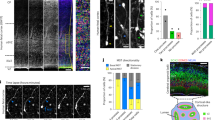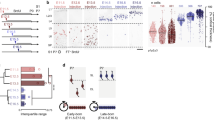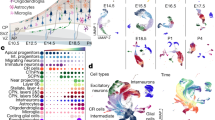Abstract
Precise patterns of cell division and migration are crucial to transform the neuroepithelium of the embryonic forebrain into the adult cerebral cortex. Using time-lapse imaging of clonal cells in rat cortex over several generations, we show here that neurons are generated in two proliferative zones by distinct patterns of division. Neurons arise directly from radial glial cells in the ventricular zone (VZ) and indirectly from intermediate progenitor cells in the subventricular zone (SVZ). Furthermore, newborn neurons do not migrate directly to the cortex; instead, most exhibit four distinct phases of migration, including a phase of retrograde movement toward the ventricle before migration to the cortical plate. These findings provide a comprehensive and new view of the dynamics of cortical neurogenesis and migration.
This is a preview of subscription content, access via your institution
Access options
Subscribe to this journal
Receive 12 print issues and online access
$209.00 per year
only $17.42 per issue
Buy this article
- Purchase on Springer Link
- Instant access to full article PDF
Prices may be subject to local taxes which are calculated during checkout







Similar content being viewed by others
Change history
12 January 2004
placed footnote in SGML where references to Supplementary videos 1-5 occur, and replaced actual legends online
Notes
*Note: In the supplementary information that was posted at the time of the initial online publication of this article, the captions accompanying Supplementary Videos 1-5 online were incorrect. This error has been corrected for the HTML version of the captions online.
References
Parnavelas, J.G. The origin and migration of cortical neurones: new vistas. Trends Neurosci. 23, 126–131 (2000).
Boulder Committee. Embryonic vertebrate central nervous system: revised terminology. Anat. Rec. 166, 257–261 (1970).
Luskin, M.B. Restricted proliferation and migration of postnatally generated neurons derived from the forebrain subventricular zone. Neuron 11, 173–189 (1993).
Letinic, K., Zoncu, R. & Rakic, P. Origin of GABAergic neurons in the human neocortex. Nature 417, 645–649 (2002).
Privat, A. Postnatal gliogenesis in the mammalian brain. Int. Rev. Cytol. 40, 281–323 (1975).
Chenn, A. & McConnell, S.K. Cleavage orientation and the asymmetric inheritance of Notch1 immunoreactivity in mammalian neurogenesis. Cell 82, 631–641 (1995).
Takahashi, T., Nowakowski, R.S. & Caviness, V.S. The leaving or Q fraction of the murine cerebral proliferative epithelium: a general model of neocortical neuronogenesis. J. Neurosci. 16, 6183–6196 (1996).
Cai, L., Hayes, N.L., Takahashi, T., Caviness, V.S., Jr., & Nowakowski, R.S. Size distribution of retrovirally marked lineages matches prediction from population measurements of cell cycle behavior. J. Neurosci. Res. 69, 731–744 (2002).
Morest, D.K. A study of neurogenesis in the forebrain of opossum pouch young. Zeitschrift fur Anatomie und Entwicklungsgeschichte 130, 265–305 (1970).
Miyata, T., Kawaguchi, A., Okano, H. & Ogawa, M. Asymmetric inheritance of radial glial fibers by cortical neurons. Neuron 31, 727–741 (2001).
Nadarajah, B., Brunstrom, J.E., Grutzendler, J., Wong, R.O. & Pearlman, A.L. Two modes of radial migration in early development of the cerebral cortex. Nat. Neurosci. 4, 143–150 (2001).
Rakic, P. Neurons in rhesus monkey visual cortex: systematic relation between time of origin and eventual disposition. Science 183, 425–427 (1974).
Noctor, S.C. et al. Dividing precursor cells of the embryonic cortical ventricular zone have morphological and molecular characteristics of radial glia. J. Neurosci. 22, 3161–3173 (2002).
Hartfuss, E., Galli, R., Heins, N. & Gotz, M. Characterization of CNS Precursor Subtypes and Radial Glia. Dev. Biol. 229, 15–30 (2001).
Mione, M.C., Danevic, C., Boardman, P., Harris, B. & Parnavelas, J.G. Lineage analysis reveals neurotransmitter (GABA or glutamate) but not calcium-binding protein homogeneity in clonally related cortical neurons. J. Neurosci. 14, 107–123 (1994).
Reid, C.B., Tavazoie, S.F. & Walsh, C.A. Clonal dispersion and evidence for asymmetric cell division in ferret cortex. Development 124, 2441–2450 (1997).
Schwartz, M.L., Rakic, P. & Goldman-Rakic, P.S. Early phenotype expression of cortical neurons: evidence that a subclass of migrating neurons have callosal axons. Proc. Natl. Acad. Sci. USA 88, 1354–1358 (1991).
Parnavelas, J.G. & Lieberman, A.R. An ultrastructural study of the maturation of neuronal somata in the visual cortex of the rat. Anat. Embryol. (Berl.) 157, 311–328 (1979).
Shoukimas, G.M. & Hinds, J.W. The development of the cerebral cortex in the embryonic mouse: an electron microscopic serial section analysis. J. Comp. Neurol. 179, 795–830 (1978).
Miller, M.W. Maturation of rat visual cortex. III. Postnatal morphogenesis and synaptogenesis of local circuit neurons. Brain Res. 390, 271–285 (1986).
Anderson, S.A., Eisenstat, D.D., Shi, L. & Rubenstein, J. Interneuron migration from basal forebrain to neocortex: dependence on dlx genes. Science 278, 474–476 (1997).
de Carlos, J.A., Lopez-Mascaraque, L. & Valverde, F. Dynamics of cell migration from the lateral ganglionic eminence in the rat. J. Neurosci. 16, 6146–6156 (1996).
Novitch, B.G., Chen, A.I. & Jessell, T.M. Coordinate regulation of motor neuron subtype identity and pan-neuronal properties by the bHLH repressor Olig2. Neuron 31, 773–789 (2001).
Bayer, S.A. & Altman, J. Neocortical Development (Raven Press, New York, 1991).
Tabata, H. & Nakajima, K. Multipolar migration: the third mode of radial neuronal migration in the developing cerebral cortex. J. Neurosci. 23, 9996–10001 (2003).
Wichterle, H., Turnbull, D.H., Nery, S., Fishell, G. & Alvarez-Buylla, A. In utero fate mapping reveals distinct migratory pathways and fates of neurons born in the mammalian basal forebrain. Development 128, 3759–3771 (2001).
Nadarajah, B., Alifragis, P., Wong, R.O. & Parnavelas, J.G. Ventricle-directed migration in the developing cerebral cortex. Nat. Neurosci. 5, 218–224 (2002).
Gleeson, J.G. & Walsh, C.A. Neuronal migration disorders: from genetic diseases to developmental mechanisms. Trends Neurosci. 23, 352–359 (2000).
Bai, J. et al. RNAi reveals doublecortin is required for radial migration in rat neocortex. Nat. Neurosci. 6, 1277–1283 (2003).
Kakita, A. et al. Bilateral periventricular nodular heterotopia due to filamin 1 gene mutation: widespread glomeruloid microvascular anomaly and dysplastic cytoarchitecture in the cerebral cortex. Acta Neuropathol. (Berl.) 104, 649–657 (2002).
Schmechel, D.E. & Rakic, P. A Golgi study of radial glial cells in developing monkey telencephalon: morphogenesis and transformation into astrocytes. Anat. Embryol. 156, 115–152 (1979).
Voigt, T. Development of glial cells in the cerebral wall of ferrets: direct tracing of their transformation from radial glia into astrocytes. J. Comp. Neurol. 289, 74–88 (1989).
Berry, M. & Rogers, A.W. The migration of neuroblasts in the developing cerebral cortex. J. Anat. 99, 691–709 (1965).
Nadarajah, B. & Parnavelas, J.G. Modes of neuronal migration in the developing cerebral cortex. Nat. Rev. Neurosci. 3, 423–432 (2002).
Parnavelas, J.G., Barfield, J.A., Franke, E. & Luskin, M.B. Separate progenitor cells give rise to pyramidal and nonpyramidal neurons in the rat telencephalon. Cereb. Cortex 1, 463–468 (1991).
Walsh, C. & Cepko, C.L. Widespread dispersion of neuronal clones across functional regions of the cerebral cortex. Science 255, 434–440 (1992).
O'Rourke, N.A., Dailey, M.E., Smith, S.J. & McConnell, S.K. Diverse migratory pathways in the developing cerebral cortex. Science 258, 299–302 (1992).
Tan, S.S. & Breen, S. Radial mosaicism and tangential cell dispersion both contribute to mouse neocortical development. Nature 362, 638–640 (1993).
Reid, C.B., Liang, I. & Walsh, C. Systematic widespread clonal organization in cerebral cortex. Neuron 15, 299–310 (1995).
Kornack, D.R. & Rakic, P. Radial and horizontal deployment of clonally related cells in the primate neocortex: relationship to distinct mitotic lineages. Neuron 15, 311–321 (1995).
Noctor, S.C., Flint, A.C., Weissman, T.A., Dammerman, R.S. & Kriegstein, A.R. Neurons derived from radial glial cells establish radial units in neocortex. Nature 409, 714–720 (2001).
Zhong, W., Jiang, M.M., Weinmaster, G., Jan, L.Y. & Jan, Y.N. Differential expression of mammalian Numb, Numblike and Notch1 suggests distinct roles during mouse cortical neurogenesis. Development 124, 1887–1897 (1997).
Cayouette, M. & Raff, M. Asymmetric segregation of Numb: a mechanism for neural specification from Drosophila to mammals. Nat. Neurosci. 5, 1265–1269 (2002).
Shen, Q., Zhong, W., Jan, Y.N. & Temple, S. Asymmetric Numb distribution is critical for asymmetric cell division of mouse cerebral cortical stem cells and neuroblasts. Development 129, 4843–4853 (2002).
Zhong, W., Feder, J.N., Jiang, M.M., Jan, L.Y. & Jan, Y.N. Asymmetric localization of a mammalian numb homolog during mouse cortical neurogenesis. Neuron 17, 43–53 (1996).
Spana, E.P. & Doe, C.Q. The prospero transcription factor is asymmetrically localized to the cell cortex during neuroblast mitosis in Drosophila. Development 121, 3187–3195 (1995).
Tarabykin, V., Stoykova, A., Usman, N., Gruss, P. Cortical upper layer neurons derive from the subventricular zone as indicated by Svet1 gene expression. Development 128, 1983–1993 (2001).
Smart, I.H., Dehay, C., Giroud, P., Berland, M. & Kennedy, H. Unique morphological features of the proliferative zones and postmitotic compartments of the neural epithelium giving rise to striate and extrastriate cortex in the monkey. Cereb. Cortex 12, 37–53 (2002).
Doetsch, F., Caillé, I., Lim, D.A., García-Verdugo, J.M. & Alvarez-Buylla, A. Subventricular zone astrocytes are neural stem cells in the adult mammalian brain. Cell 97, 703–716 (1999).
Seri, B., García-Verdugo, J.M., McEwen, B.S. & Alvarez-Buylla, A. Astrocytes give rise to new neurons in the adult mammalian hippocampus. J. Neurosci. 21, 7153–7160 (2001).
Acknowledgements
We thank J. Goldman and members of the Kriegstein Lab for helpful comments on the manuscript, and W. Wong and J. Mirjahangir for technical assistance. This work was supported by National Institutes of Health grants (NS21223, NS38658 and NS35710) to A.R.K.
Author information
Authors and Affiliations
Corresponding author
Ethics declarations
Competing interests
The authors declare no competing financial interests.
Supplementary information
Supplementary Video 1. Symmetric radial glial cell division.
Radial glial cells predominantly undergo asymmetric divisions, but also undergo symmetric progenitor divisions at the ventricular surface during late stages of neurogenesis. A radial glial cell is shown dividing with a vertical cleavage plane (t = 4 h). The resulting daughter cells have identical radial glial cell morphology and remain in the VZ for the length of the experiment (65 h, 45 h shown).* (MOV 2462 kb)
Supplementary Video 2. Neocortical neurons exhibit four distinct phases of migration.
Shown is a GFP+ multipolar single cell clone in the SVZ that had been labeled through an in utero retroviral injection one day prior to imaging. At the start of the time-lapse movie, the multipolar neuron is in the second phase of migration - migratory arrest in the SVZ. The neuron enters phase three of migration (retrograde movement toward the ventricle) and contacts the ventricular surface (t = 14 - 20 h). The neuron maintains contact with the ventricular surface, reverses polarity by developing a new leading process (t = 24 - 32 h), and migrates radially to the cortical plate.* (MOV 895 kb)
Supplementary Video 3. Intermediate precursor cells divide in the SVZ to generate pairs of neurons that also exhibit retrograde movement before migration to the cortical plate.
These paired cells progress through the phases of migration in tandem, and appear to interact as they migrate in close proximity to one another. The migrating cells can temporarily extend leading processes that reach the pia (t = 61 h), but then retract as the cells continue migrating.* (MOV 3046 kb)
Supplementary Video 4. Neocortical neurons leave a trailing axon in the ventricular zone during radial migration.
Many neocortical neurons that undergo retrograde migration to the ventricle leave a trailing process at the ventricular surface that remains in the VZ during radial migration. The leading process of the neuron during retrograde movement toward the ventricle becomes the trailing process as the neuron migrates radially to the cortical plate. The process remains in the VZ and lengthens by growing tangentially. The processes were morphologically identified as axons based on their thin uniform caliber and active growth cones.* (MOV 1792 kb)
Supplementary Video 5. Radial glial cells undergo final divisions to generate translocating radial glia and intermediate progenitor cells.
A radial glial cell is shown at the beginning of the time-lapse experiment. Its processes contact both the ventricular and pial surfaces of the cultured slice (200 μm width). The cortex grows during the experiment (700 μm width) beyond the initial field of view, but the radial glial cell maintains contact with the pial surface. The radial glial cell (red arrowhead) divides asymmetrically in the VZ (t = 23.5 h) to generate a presumed daughter neuron (white arrowhead) that undergoes retrograde movement toward the ventricle (t = 40.5 - 51.5 h) before migrating toward the cortical plate (t = 73 - 79 h) and moving deep into the tissue and out of the range of laser detection (t = 100 h). The radial glial cell divides a final time (t = 51.5 h). One daughter cell inherits the pial fiber and translocates toward the cortex (red arrowhead), while the other becomes multipolar (red arrow) and divides to generate a third cell (blue arrowhead) that can be seen at t = 112 h.* (MOV 849 kb)
*Note: In the supplementary information that was posted at the time of the initial online publication of this article, the captions accompanying Supplementary Videos 1-5 online were incorrect. This error has been corrected for the HTML version of the captions online.
Rights and permissions
About this article
Cite this article
Noctor, S., Martínez-Cerdeño, V., Ivic, L. et al. Cortical neurons arise in symmetric and asymmetric division zones and migrate through specific phases. Nat Neurosci 7, 136–144 (2004). https://doi.org/10.1038/nn1172
Received:
Accepted:
Published:
Issue Date:
DOI: https://doi.org/10.1038/nn1172
This article is cited by
-
A cell fate decision map reveals abundant direct neurogenesis bypassing intermediate progenitors in the human developing neocortex
Nature Cell Biology (2024)
-
Developmental loss of NMDA receptors results in supernumerary forebrain neurons through delayed maturation of transit-amplifying neuroblasts
Scientific Reports (2024)
-
Expression patterns of Piezo1 in the developing mouse forebrain
Brain Structure and Function (2024)
-
Neocortex neurogenesis and maturation in the African greater cane rat
Neural Development (2023)
-
Integrative single-cell RNA-seq analysis of vascularized cerebral organoids
BMC Biology (2023)



